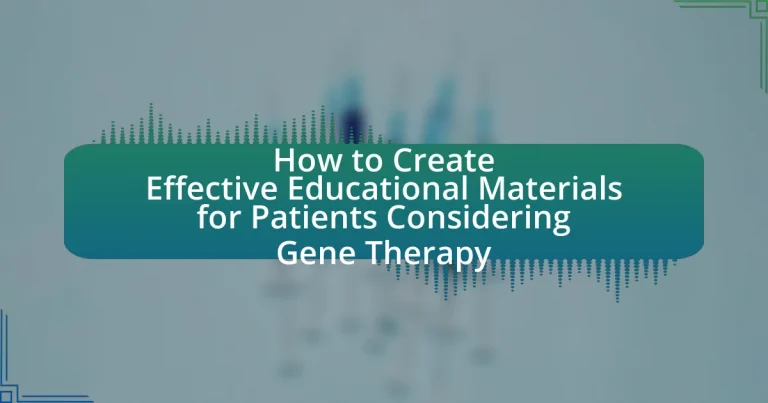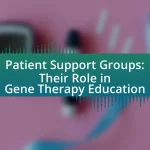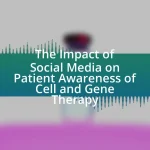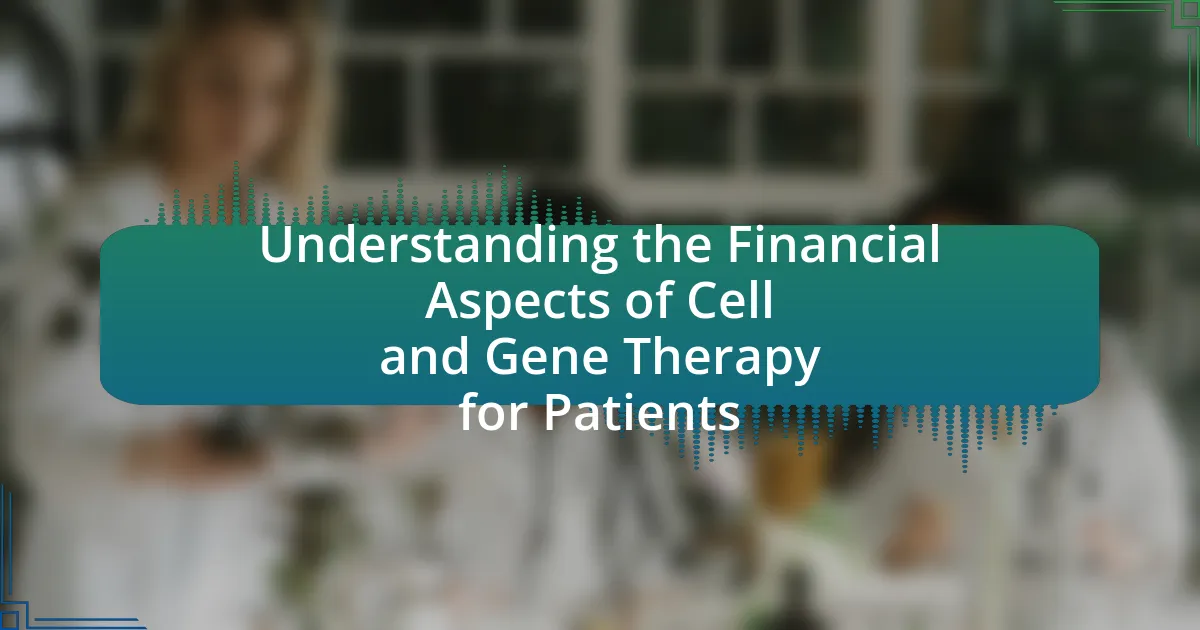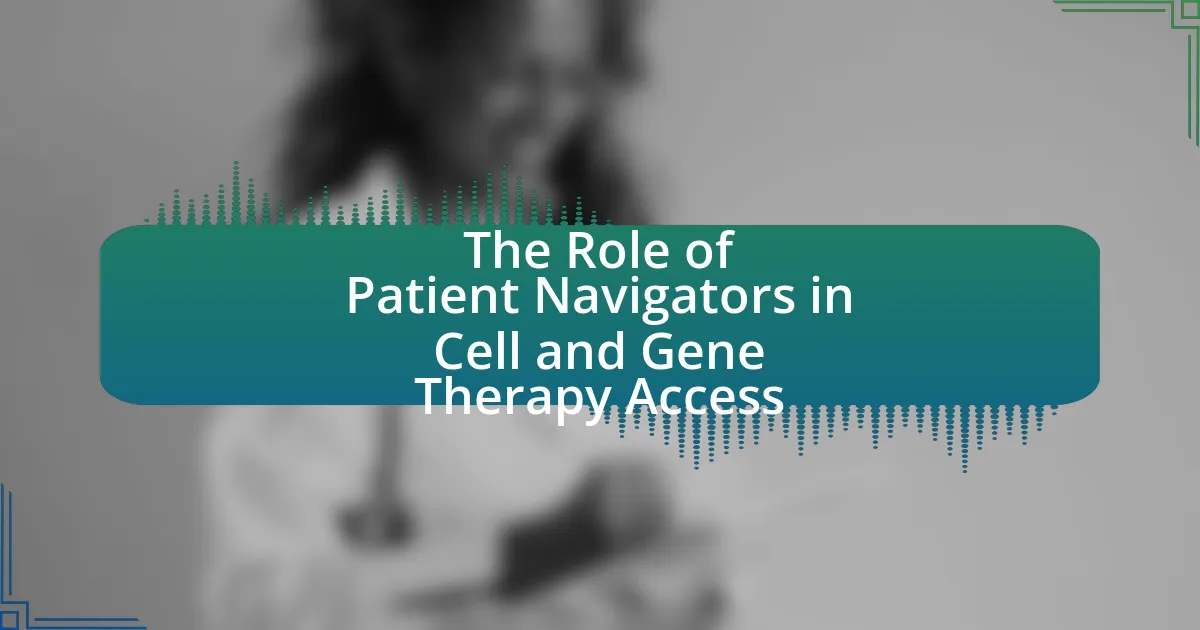The article focuses on creating effective educational materials for patients considering gene therapy. It emphasizes the importance of clear communication through brochures, interactive websites, and videos that explain the therapy’s purpose, process, and potential outcomes. Key elements include using simple language, visual aids, and real-life case studies to enhance understanding and decision-making. The article also discusses the impact of tailored materials on patient comprehension, the role of healthcare professionals in developing these resources, and the significance of cultural and linguistic considerations. Additionally, it highlights best practices for material creation, the effectiveness of various formats, and future trends in patient education tools.
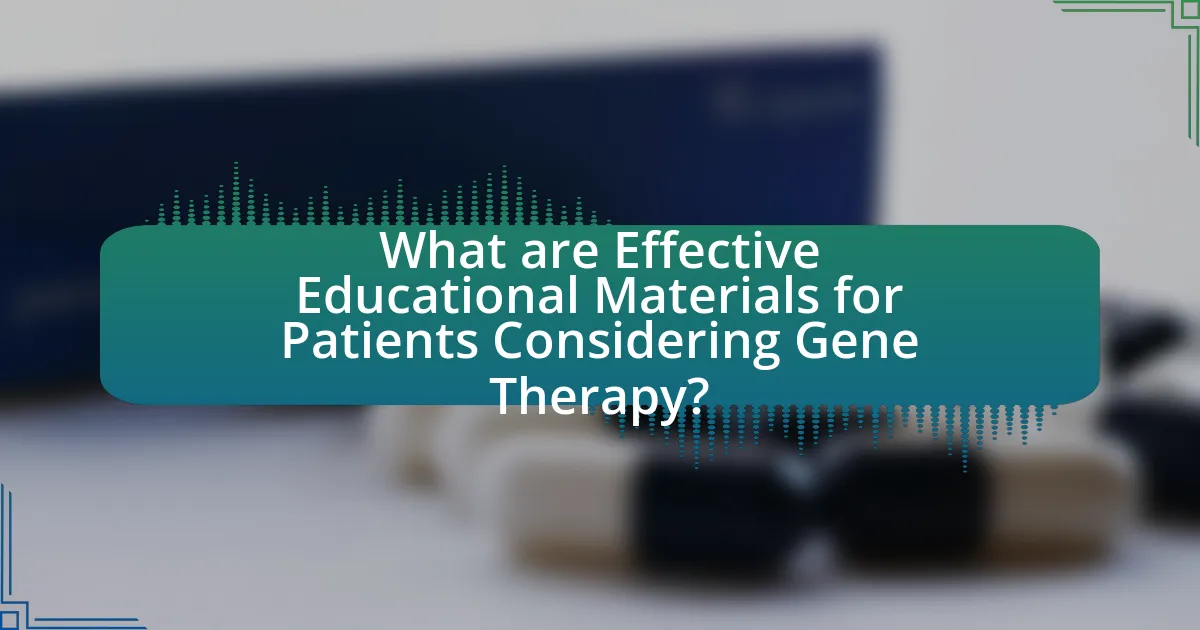
What are Effective Educational Materials for Patients Considering Gene Therapy?
Effective educational materials for patients considering gene therapy include clear brochures, interactive websites, and videos that explain the therapy’s purpose, process, and potential outcomes. These materials should use simple language, visual aids, and real-life case studies to enhance understanding. Research indicates that patients who receive well-structured educational resources are more likely to comprehend complex medical information, leading to informed decision-making. For instance, a study published in the Journal of Genetic Counseling found that patients who accessed multimedia educational tools reported higher satisfaction and understanding of gene therapy options compared to those who received standard verbal explanations.
How do these materials impact patient understanding and decision-making?
Educational materials significantly enhance patient understanding and decision-making regarding gene therapy. These materials provide clear, accessible information about the therapy’s benefits, risks, and processes, which helps patients make informed choices. Research indicates that patients who receive well-structured educational resources demonstrate improved comprehension of complex medical concepts, leading to greater confidence in their treatment decisions. For instance, a study published in the Journal of Genetic Counseling found that patients exposed to tailored educational materials had a 30% increase in understanding of gene therapy compared to those who did not receive such resources. This evidence underscores the critical role of effective educational materials in facilitating informed patient engagement in their healthcare decisions.
What key information should be included in these materials?
Key information that should be included in educational materials for patients considering gene therapy includes a clear explanation of gene therapy, its purpose, potential benefits, risks, and side effects. Additionally, materials should provide information on the specific condition being treated, the mechanism of action of the therapy, and the expected outcomes. Evidence-based statistics on success rates and patient testimonials can enhance understanding and trust. Furthermore, details about the treatment process, including preparation, administration, and follow-up care, are essential for patient preparedness. Lastly, resources for support and further information should be included to assist patients in making informed decisions.
How can visuals enhance the effectiveness of educational materials?
Visuals enhance the effectiveness of educational materials by improving comprehension and retention of information. Research indicates that people retain 65% of information when paired with relevant visuals, compared to only 10% when presented with text alone. This is particularly important in complex subjects like gene therapy, where visuals can simplify intricate concepts, making them more accessible to patients. Additionally, visuals can engage learners emotionally, fostering a deeper connection to the material, which is crucial for understanding treatment options and making informed decisions.
Why is it important to tailor materials for patients considering gene therapy?
Tailoring materials for patients considering gene therapy is crucial because personalized information enhances understanding and decision-making. Patients have diverse backgrounds, levels of health literacy, and specific concerns regarding gene therapy, which necessitates customized educational resources. Research indicates that tailored communication improves patient engagement and satisfaction, leading to better adherence to treatment plans. For instance, a study published in the Journal of Genetic Counseling found that personalized educational materials significantly increased patients’ knowledge and comfort levels regarding gene therapy options.
What specific needs do patients have when learning about gene therapy?
Patients have specific needs when learning about gene therapy, including clear information about the therapy’s mechanism, potential benefits, risks, and the implications for their health. Patients require understandable explanations that demystify complex scientific concepts, as studies show that health literacy significantly impacts patient decision-making and adherence to treatment plans. Additionally, patients need access to personalized information that considers their unique medical history and genetic background, which can enhance their understanding and comfort level with the therapy. Research indicates that tailored educational materials improve patient engagement and satisfaction, ultimately leading to better health outcomes.
How can cultural and linguistic factors influence material design?
Cultural and linguistic factors significantly influence material design by shaping how information is perceived and understood by diverse audiences. For instance, cultural beliefs and values can dictate the appropriateness of certain images, colors, and symbols used in educational materials, ensuring they resonate with the target demographic. Additionally, language proficiency affects comprehension; materials must be tailored to the linguistic abilities of patients, utilizing clear and accessible language to enhance understanding. Research indicates that culturally adapted materials improve patient engagement and knowledge retention, as seen in studies like “Cultural Adaptation of Health Information” by Kreuter et al., which highlights the effectiveness of culturally relevant content in health education.
What are the best practices for creating these educational materials?
The best practices for creating educational materials for patients considering gene therapy include ensuring clarity, using plain language, and incorporating visual aids. Clarity is essential as it helps patients understand complex concepts; studies show that patients retain information better when it is presented in straightforward terms. Using plain language avoids medical jargon, making the content accessible to a broader audience. Incorporating visual aids, such as diagrams and infographics, enhances comprehension and retention, as visual information is processed faster than text. Additionally, engaging patients through interactive elements, such as quizzes or FAQs, can further reinforce understanding and retention of the material.
How can feedback from patients improve material effectiveness?
Feedback from patients can significantly improve material effectiveness by providing insights into their understanding, preferences, and needs regarding educational content. When patients share their experiences and challenges with existing materials, healthcare providers can identify gaps in information, clarity, and engagement. For instance, a study published in the Journal of Medical Internet Research found that incorporating patient feedback led to a 30% increase in comprehension of educational materials related to gene therapy. This demonstrates that patient input not only enhances the relevance of the content but also ensures that it is tailored to the audience’s specific concerns, ultimately leading to better patient outcomes and satisfaction.
What role do healthcare professionals play in developing these materials?
Healthcare professionals play a crucial role in developing educational materials for patients considering gene therapy by providing expert knowledge and clinical insights. Their expertise ensures that the content is accurate, relevant, and tailored to the specific needs of patients, facilitating better understanding of complex medical concepts. For instance, healthcare professionals can identify common patient misconceptions and address them directly in the materials, enhancing clarity and comprehension. Additionally, their involvement in the development process helps to ensure that the materials comply with ethical standards and regulatory guidelines, which is essential in the context of gene therapy.
How can we ensure accessibility in educational materials for gene therapy?
To ensure accessibility in educational materials for gene therapy, it is essential to use clear language, visual aids, and multiple formats. Clear language simplifies complex concepts, making them understandable for diverse audiences, while visual aids like diagrams and videos enhance comprehension. Additionally, providing materials in various formats, such as print, digital, and audio, accommodates different learning preferences and disabilities. Research indicates that using plain language and multimedia can significantly improve patient understanding and engagement, as demonstrated in studies like “Health Literacy and Patient Safety: Help Patients Understand” by the Agency for Healthcare Research and Quality, which highlights the importance of accessible communication in healthcare settings.
What are the common challenges faced in creating these materials?
Common challenges faced in creating educational materials for patients considering gene therapy include ensuring accurate scientific content, addressing diverse patient literacy levels, and maintaining engagement. Accurate scientific content is crucial, as misinformation can lead to misunderstandings about gene therapy’s risks and benefits. A study published in the Journal of Genetic Counseling highlights that 40% of patients struggle to comprehend complex genetic information, emphasizing the need for materials that cater to varying literacy levels. Additionally, maintaining patient engagement is challenging; materials must be visually appealing and interactive to hold attention, as research indicates that interactive content increases retention rates by up to 60%.
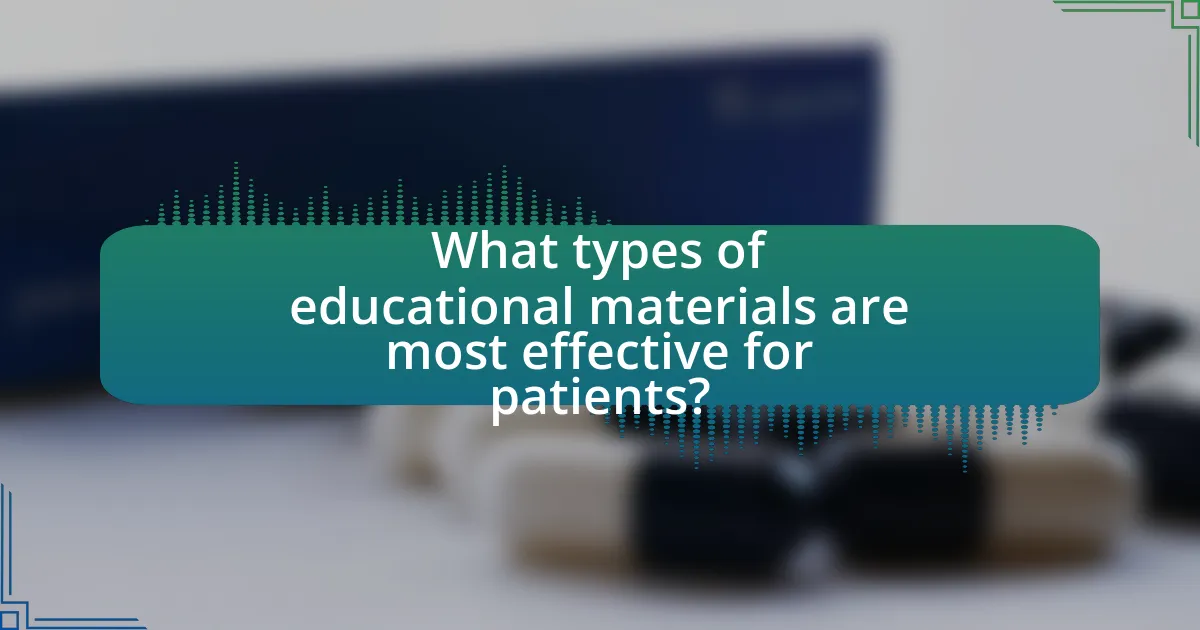
What types of educational materials are most effective for patients?
Visual aids, such as infographics and videos, are the most effective educational materials for patients. These materials enhance understanding by simplifying complex information and making it more accessible. Research indicates that visual learning can improve retention rates by up to 65%, compared to 10% for verbal information alone. Additionally, written materials like brochures and pamphlets that use clear language and are tailored to the patient’s literacy level also prove effective, as they provide a reference that patients can revisit. Studies show that patients who receive well-designed educational materials are more likely to adhere to treatment plans and report higher satisfaction with their care.
How do printed materials compare to digital formats?
Printed materials provide a tangible, distraction-free experience that can enhance comprehension and retention, while digital formats offer convenience and accessibility. Research indicates that individuals often retain information better when reading printed text compared to digital screens, with a study published in the International Journal of Educational Research showing that students performed better on comprehension tests after reading printed materials. Additionally, printed materials do not require electronic devices or internet access, making them more reliable in various settings, particularly for patients who may have limited technological proficiency. Conversely, digital formats allow for easy updates and interactive features, which can engage users in ways that printed materials cannot.
What are the advantages of using videos in patient education?
Videos in patient education enhance understanding and retention of complex medical information. They provide visual and auditory stimuli that cater to different learning styles, making it easier for patients to grasp intricate concepts related to gene therapy. Research indicates that patients who engage with video content demonstrate improved comprehension and recall compared to those who receive traditional printed materials. For instance, a study published in the Journal of Medical Internet Research found that video-based education significantly increased patient knowledge and satisfaction levels regarding their treatment options. This evidence underscores the effectiveness of videos in conveying essential information in a clear and engaging manner.
How can interactive tools enhance patient engagement?
Interactive tools enhance patient engagement by providing personalized, real-time feedback and facilitating active participation in their healthcare journey. These tools, such as mobile apps and online platforms, allow patients to track their symptoms, access educational resources, and communicate directly with healthcare providers. Research indicates that patients who use interactive tools report higher satisfaction and adherence to treatment plans, as evidenced by a study published in the Journal of Medical Internet Research, which found that 70% of patients using such tools felt more empowered in managing their health.
What role does language play in the effectiveness of educational materials?
Language is crucial in determining the effectiveness of educational materials, as it directly influences comprehension and engagement. Clear, concise, and accessible language ensures that patients can easily understand complex concepts related to gene therapy. Research indicates that using plain language can improve patient comprehension by up to 80%, making it essential for effective communication. Additionally, culturally relevant language enhances relatability and trust, further increasing the likelihood that patients will engage with the material and retain the information presented.
How can we simplify complex medical terminology for patients?
To simplify complex medical terminology for patients, healthcare providers should use plain language and avoid jargon. This approach enhances patient understanding and engagement, as studies show that patients are more likely to comprehend their health conditions and treatment options when information is presented clearly. For instance, the National Institutes of Health emphasizes the importance of using everyday language and providing definitions for necessary technical terms, which can significantly improve patient literacy and decision-making in healthcare settings.
What strategies can be used to ensure clarity in communication?
To ensure clarity in communication, utilize strategies such as simplifying language, organizing information logically, and using visual aids. Simplifying language involves avoiding jargon and complex terms, which can confuse patients; studies show that plain language improves understanding by up to 80%. Organizing information logically helps patients follow the content easily, as a structured approach enhances retention and comprehension. Additionally, incorporating visual aids like diagrams or charts can reinforce verbal messages, making complex concepts more accessible; research indicates that visuals can increase information retention by 65%.
How can we evaluate the effectiveness of educational materials?
To evaluate the effectiveness of educational materials, one can employ methods such as pre- and post-assessments, surveys, and focus groups. Pre- and post-assessments measure knowledge gained by comparing scores before and after exposure to the materials, providing quantitative data on learning outcomes. Surveys can gather feedback on clarity, relevance, and engagement, while focus groups allow for in-depth discussions about the materials’ impact on understanding and decision-making. Research indicates that using these evaluation methods can lead to improvements in educational content, as evidenced by a study published in the Journal of Medical Education, which found that structured feedback significantly enhanced the quality of patient education resources.
What metrics should be used to assess patient understanding?
To assess patient understanding, metrics such as comprehension tests, teach-back methods, and patient surveys should be utilized. Comprehension tests evaluate the patient’s ability to recall and explain key concepts related to their treatment, while teach-back methods involve asking patients to repeat information in their own words to confirm understanding. Patient surveys can gather feedback on clarity and usefulness of educational materials. Research indicates that these methods effectively measure understanding and improve patient engagement, as evidenced by studies showing that patients who can accurately explain their treatment options are more likely to adhere to prescribed therapies.
How can we gather patient feedback effectively?
To gather patient feedback effectively, implement structured surveys and focus groups that target specific aspects of the educational materials. Research indicates that using validated survey tools, such as the Patient Satisfaction Questionnaire, can yield reliable insights into patient experiences and comprehension. Additionally, conducting focus groups allows for in-depth discussions, enabling patients to express their thoughts and suggestions in a collaborative environment. This method has been shown to enhance the quality of feedback, as it encourages open dialogue and clarifies any misunderstandings regarding the educational content.
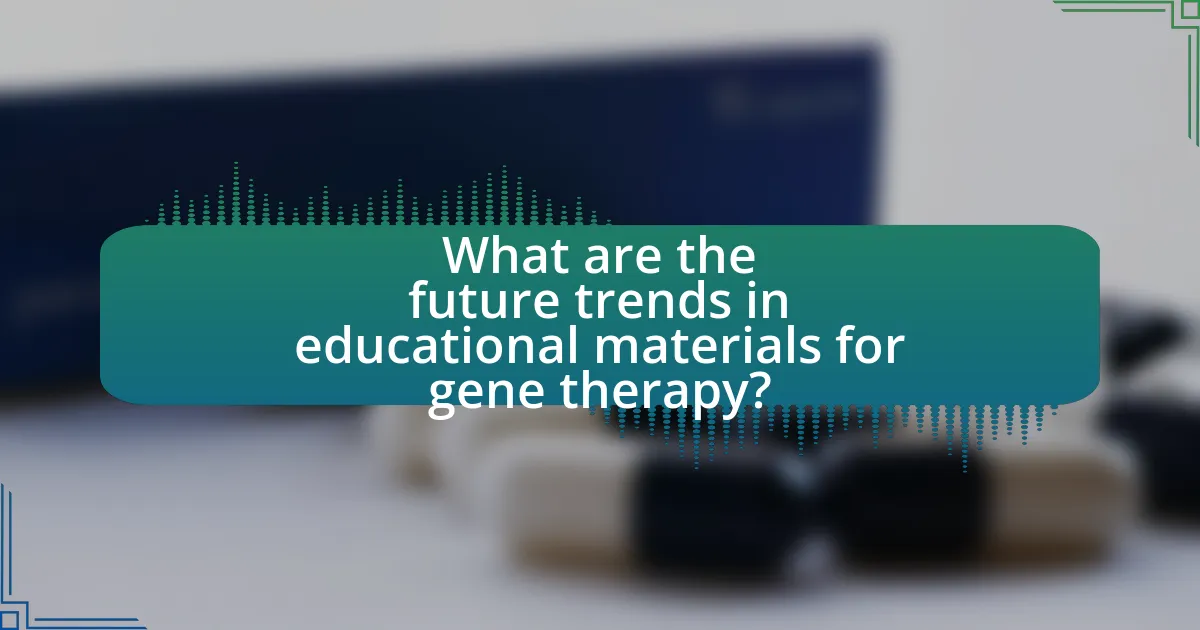
What are the future trends in educational materials for gene therapy?
Future trends in educational materials for gene therapy include the integration of digital platforms, personalized content, and interactive learning tools. Digital platforms, such as mobile applications and online courses, enable patients to access information anytime, enhancing understanding and engagement. Personalized content tailored to individual patient needs and genetic backgrounds improves relevance and comprehension. Interactive learning tools, including virtual reality and simulations, provide immersive experiences that facilitate better retention of complex concepts. These trends are supported by research indicating that personalized and interactive educational approaches significantly enhance patient knowledge and decision-making in healthcare contexts.
How is technology shaping the development of these materials?
Technology is significantly shaping the development of educational materials for patients considering gene therapy by enabling personalized content delivery and enhancing interactivity. Digital platforms allow for the customization of information based on individual patient needs, preferences, and comprehension levels, which improves engagement and understanding. For instance, interactive multimedia tools, such as videos and simulations, facilitate complex concepts related to gene therapy, making them more accessible. Research indicates that patients who engage with interactive educational materials demonstrate higher retention rates and satisfaction levels compared to traditional formats. This evidence underscores the effectiveness of technology in creating tailored educational experiences that empower patients in their healthcare decisions.
What innovations are emerging in patient education tools?
Innovations in patient education tools include the use of interactive digital platforms, personalized mobile applications, and virtual reality experiences. These tools enhance patient understanding by providing tailored information that meets individual learning preferences and needs. For instance, interactive platforms allow patients to engage with content actively, improving retention and comprehension. Personalized mobile applications can deliver reminders and educational resources based on specific treatment plans, while virtual reality experiences can simulate medical procedures, helping patients visualize and understand complex concepts. Research indicates that such innovations lead to increased patient engagement and satisfaction, ultimately improving health outcomes.
How can artificial intelligence be utilized in creating personalized materials?
Artificial intelligence can be utilized in creating personalized materials by analyzing patient data to tailor educational content to individual needs. AI algorithms can process information such as genetic profiles, medical histories, and learning preferences, enabling the development of customized resources that enhance understanding of gene therapy. For instance, a study published in the Journal of Medical Internet Research demonstrated that AI-driven platforms improved patient engagement by delivering personalized educational materials based on user interactions and feedback. This targeted approach not only increases comprehension but also fosters better decision-making regarding treatment options.
What are the implications of evolving patient education strategies?
Evolving patient education strategies significantly enhance patient engagement and understanding of gene therapy. These strategies incorporate technology, personalized content, and interactive formats, which lead to improved health literacy and informed decision-making. Research indicates that patients who receive tailored educational materials are more likely to adhere to treatment plans and report higher satisfaction levels with their care. For instance, a study published in the Journal of Medical Internet Research found that digital educational tools increased knowledge retention by 30% compared to traditional methods. This evolution in education not only empowers patients but also fosters better communication between healthcare providers and patients, ultimately improving health outcomes.
How can we prepare for changes in patient demographics and needs?
To prepare for changes in patient demographics and needs, healthcare organizations must implement data-driven strategies that assess and anticipate shifts in population characteristics. This involves regularly analyzing demographic data, such as age, ethnicity, and socioeconomic status, to identify emerging trends and tailor educational materials accordingly. For instance, a study by the Pew Research Center indicates that by 2030, the U.S. population aged 65 and older will reach 20%, necessitating materials that address the specific health concerns of older adults. Additionally, engaging with diverse community stakeholders can provide insights into cultural preferences and barriers to understanding gene therapy, ensuring that educational resources are accessible and relevant.
What role will telehealth play in the future of patient education?
Telehealth will play a crucial role in the future of patient education by providing accessible, real-time information and support tailored to individual patient needs. This technology enables healthcare providers to deliver educational materials through virtual platforms, ensuring that patients receive timely and relevant information about their conditions and treatment options, including gene therapy. Studies indicate that telehealth can enhance patient understanding and engagement, as evidenced by a 2021 report from the American Journal of Managed Care, which found that patients who utilized telehealth services demonstrated improved knowledge retention and satisfaction with their care.
What practical tips can be applied when creating educational materials for patients considering gene therapy?
When creating educational materials for patients considering gene therapy, it is essential to use clear and simple language to ensure comprehension. This approach is supported by research indicating that patients with a better understanding of medical information are more likely to engage in their treatment decisions. Visual aids, such as diagrams and infographics, can enhance understanding by illustrating complex concepts, as studies show that visual learning can improve retention of information. Additionally, including real-life case studies can help patients relate to the material, making it more relevant and easier to grasp. Providing a glossary of terms can also assist in demystifying medical jargon, which is crucial since studies reveal that patients often struggle with technical language. Lastly, ensuring that materials are culturally sensitive and tailored to the specific demographics of the patient population can increase accessibility and effectiveness, as evidenced by research highlighting the importance of cultural competence in healthcare communication.
